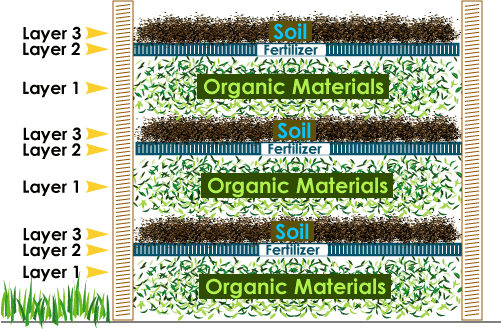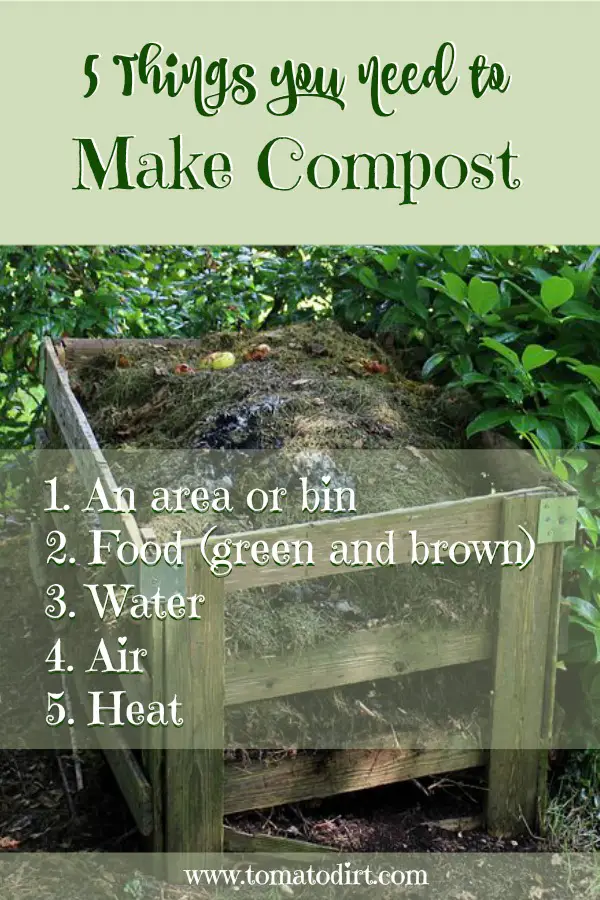FREE: 10 Must-Know Tomato Growing Tips Get The Guide
Read our affiliate disclosure here.
Composting Basics to Get You Started
Since 2010, Tomato Dirt has garnered 4.8+ million views, making it the web’s leading online source for growing tomatoes in the home garden. Award-winning writer and Tomato Dirt owner Kathy Widenhouse has helped thousands of home gardeners grow healthier tomatoes. Be one of them when you get Tomato Dirt’s Growing Guide here.
Updated 9.30.25
Composting is a process. The result is what gardeners have come to call “black gold.” Microorganisms feed on organic matter, breaking it down into humus, considered a stable soil conditioner. Make sure you include this important component in your garden soil as you grow tomatoes.
You can make it or buy it. If you have limited space or live in an apartment, you can buy compost to add to your soil. If you have just a corner of space in your yard, you can start your own bin or pile to make it.
The process for creating "black gold" is quite simple.
At its most basic level, organic matter (like leaves and grass) gets wet and breaks down over a period of weeks or months – as it naturally happens on the forest floor, for instance.
However, the process can become as involved as you like. Many gardeners take a more structured composting approach by using measured amounts of carbon-rich- and nitrogen-rich organic matter, proper aeration, proportional amounts of water to move along the decomposition process in a more systematic manner. Some gardeners can even get quite scientific about it.
At Tomato Dirt, were interested in giving you the information you need to make compost for your tomatoes at whatever level of simplicity or complexity you prefer. We’ll start with the basics. Here’s the dirt.
Why is "black gold" so good for tomatoes?
Tomatoes are heavy feeders. They need healthy, rich soil in order to produce a good crop.
Although not particularly high in essential nutrients, compost is a valuable soil amendment. It operates as a soil conditioner, helping improve poor soil or rebuilding the soil in your overused tomato patch.
Adding it to the soil can also help keep an excellent garden in peak condition … adding to its value as “black gold.”
What you need to make it
In order to create compost, you need a designated area to set up the process. Your area can be as large or as small as you like.
There are two basic kinds of piles: open bins and enclosed containers.
- Open bins can be constructed with wood, wire, or recycled plastic. By definition, as you construct an open bin, you create a means to open and close one or more sides, giving you access to add organic matter, turn the pile, and remove the mature humus to use in the garden once it is ready. Small piles can be turned with a pitchfork. Large piles can be assembled without any walls at all. The organic matter is turned and moved by tractors. Rain will moisten an open pile. By positioning it with access to a garden hose you provide a means to moisten the pile during a drought.
- Enclosed containers usually consist of one of two designs: upright box-like containers and rotating drums. These composters have an opening to add materials and water. A rotating drum is set up to allow the entire container to be turned, making it easier to mix the materials. Organic matter in an upright box must be manually turned.
Where should you put your bin or pile?
If possible, set your bin in the sun to encourage heat and air flow. You may want to consider placing it in a protected area so that it is not an eyesore, yet still in a place that provides easy access to your kitchen so you can routinely add scraps to the pile. Make sure the pile is accessible to your garden hose so you can periodically moisten it.
What you need to make "black gold"
Successful composting requires four components: food, water, air, and heat. These raw materials and environmental factors combine to facilitate the process.
Food
Organic matter provides the fuel. The right mixture includes two primary materials, simply referred to as “greens” and “browns.” These designations don’t necessarily refer to the actual color of the material. Rather, green materials (grass clippings, weeds, and kitchen scraps for example) are high in nitrogen, while brown materials are high in carbon (like dry leaves and corn stalks.) The best combination is about 3-4 parts of browns to one part greens by volume. By weight, the best proportion is about 50% green (nitrogen-rich materials) and 50% brown (carbon-rich materials.)
 |
Image: University of Illinois Extension |
To layer a bin or pile, begin with a 6 – 8 inch mixture of shredded green and brown materials. Broadcast a few handfuls of fertilizer or animal manure to help the compost pile heat up. Spread a thin layer of soil as a way of adding hungry microorganisms to jumpstart the breakdown process. Repeat layering a few times to build your pile.
Water
Set your bin or pile in an area with good drainage so that it can receive moisture but will avoid accumulating excess water. Moisten the pile with a garden hose when it gets dry in order to allow the decomposition process to proceed. If your pile is in a bin, remove the cover when rain is in the forecast.
Air
Aerobic microorganisms in your bin or pile need air to survive and to continue their work of breaking down organic matter. When the pile receives little oxygen, anaerobic microorganisms flourish, leading to fermentation. That’s why your bin or pile may occasionally produce a foul odor. It’s nature’s way of telling you to turn its contents and allow more air into the interior.
Turning opens up air pockets in the pile. By “turning” the organic matter, you help microorganisms on the outside of the pile move into the middle, where there is more heat, which promotes breakdown. Turning also encourages overly-wet materials to dry out and maintain a more consistent level of moisture.
You can turn a smaller open bin pile using a pitchfork. Larger stacks require a tractor. Materials in enclosed rotating containers simply can be flipped.
Heat
Organic matter decomposes the quickest between 140ºF - 160ºF. Some breakdown will occur as long as the internal pile or bin temperature is above freezing. Materials in the pile are self-insulating. The middle of the pile will be the warmest.
More on making compost for tomatoes ...
Get Started Composting In The Fall: A Quick Guide ...
When to compost: a guide to composting through 4 seasons...
4 Types of Compost Bins: Which Is Best for You?
How to Compost Tomato Plants ...
Compost Containers For Outside: Which Is Right for You?
2 types of composting for the home gardener ...
How to use a kitchen compost bin to make black gold ...
More composting tips on our Pinterest board ...
Return from Composting Basics to Get You Started to Tomato Dirt home
As an Amazon Associate and Rakuten Advertising affiliate I earn from qualifying purchases.
SHARE THIS PAGE:
FREE! 10 Must-Know Tomato Growing Tips: 20-page guide
Get yours here:





New! Comments
Have your say about what you just read! Leave a comment in the box below.